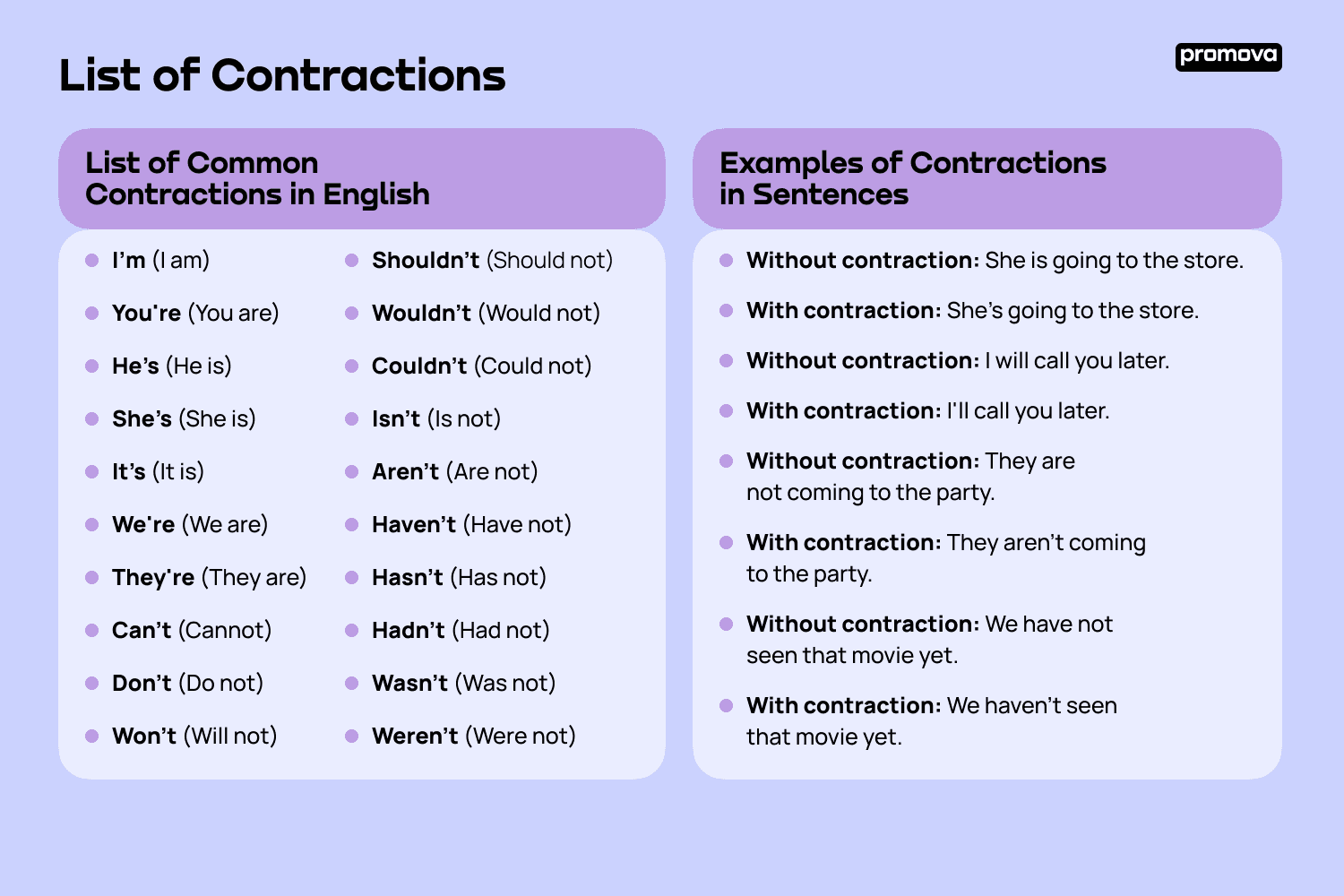List of Contractions
Contents
If you're learning English, you've probably come across contractions in your studies. These are shortened versions of two words, usually a pronoun and a verb, that are used to make sentences more concise and natural-sounding. In this reference, we'll explore what contractions are, why they're used, and provide a list of common contractions in English.
What are Contractions and Why are They Used?
Contractions are a form of abbreviation that are used to combine two words into one. They are commonly used in spoken English, but are also frequently used in informal writing, such as emails and text messages. Contractions are used to make sentences more concise, natural-sounding, and easier to say.
For example, instead of saying "I am going to the store," you can say "I'm going to the store." By using a contraction, you save a syllable and make the sentence flow more smoothly.

List of Common Contractions in English
Commonly used contractions in English:
- I'm (I am)
- You're (You are)
- He's (He is)
- She's (She is)
- It's (It is)
- We're (We are)
- They're (They are)
- Can't (Cannot)
- Don't (Do not)
- Won't (Will not)
- Shouldn't (Should not)
- Wouldn't (Would not)
- Couldn't (Could not)
- Isn't (Is not)
- Aren't (Are not)
- Haven't (Have not)
- Hasn't (Has not)
- Hadn't (Had not)
- Wasn't (Was not)
- Weren't (Were not)
List of Contraction Words
In slang, you'll sometimes encounter contractions replacing entire words:
- 'd (would or had)
- 'll (will)
- 've (have)
- 're (are)
- 'm (am)
Contractions Grammar Rules
There are some grammar rules you need to follow when using contractions in English.
- Use an apostrophe (') to replace the missing letters.
- Use contractions in informal writing and speech only.
- Do not use contractions in formal writing, such as academic papers or business letters.
- Avoid using contractions in negative questions, such as "Isn't it?" or "Aren't you?"
- Use contractions in affirmative questions, such as "Can't you?" or "Won't you?"
8
Examples of Contractions in Sentences
To better understand how contractions are used in English, here are some examples of sentences with and without contractions:
- Without contraction: She is going to the store.
- With contraction: She's going to the store.
- Without contraction: I will call you later.
- With contraction: I'll call you later.
- Without contraction: They are not coming to the party.
- With contraction: They aren't coming to the party.
- Without contraction: We have not seen that movie yet.
- With contraction: We haven't seen that movie yet.
Using Contractions in Formal vs. Informal Writing
As mentioned earlier, contractions are commonly used in informal writing and speech, but are not appropriate for formal writing. In formal writing, such as business letters or academic papers, it's important to use full words and avoid contractions.
Using contractions in formal writing can make your writing appear less professional and may negatively impact your credibility. Err on the side of caution and try not to overuse contractions in formal writing.
Contractions to Avoid in Formal Writing
While there are many contractions that are appropriate for informal writing and speech, there are some that should be avoided in formal writing. Here are some examples:
- ain't (am not, is not, are not, has not, have not)
- gonna (going to)
- wanna (want to)
- gimme (give me)
- lemme (let me)
- kinda (kind of)
Using these contractions in formal writing can make you appear unprofessional and may negatively impact your credibility.
Summary
Contractions are a common feature of English grammar, used to combine two words into one. They are commonly used in informal writing and speech, but should be avoided in formal writing.
By using contractions in your writing and speech, you can make your sentences more concise, natural-sounding, and easier to say. Practice using them in your everyday life and you'll quickly become comfortable with this simplified way of saying things!



Comments